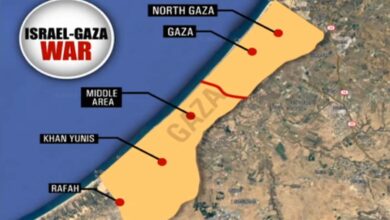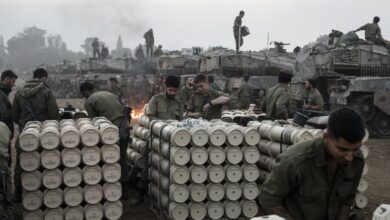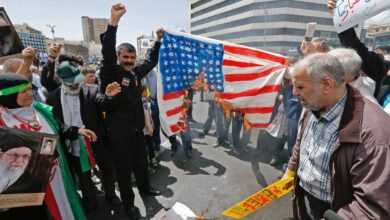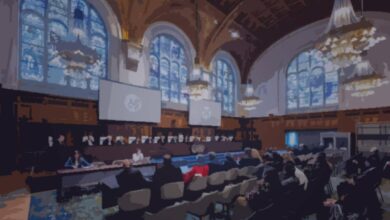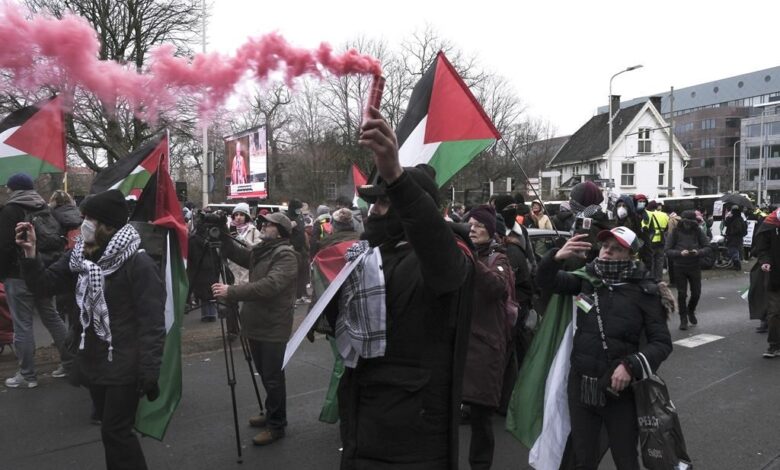
South Africa Israel Genocide A Complex History
South Africa Israel genocide: A complex and often contentious history unfolds, examining accusations of atrocities and genocide in both nations. This exploration delves into the historical context of both countries, their evolving relationships, and the arguments surrounding these serious allegations. It’s a journey through decades of political, social, and economic interactions, highlighting the perspectives of various groups and the impact on individuals and communities.
From the apartheid era in South Africa to the Israeli-Palestinian conflict, the narrative reveals a tangled web of events, policies, and actions. This investigation seeks to understand the historical context, the legal definition of genocide, and the potential connections between these seemingly disparate events. Ultimately, it aims to offer a nuanced perspective on the complexities of these accusations.
Historical Context
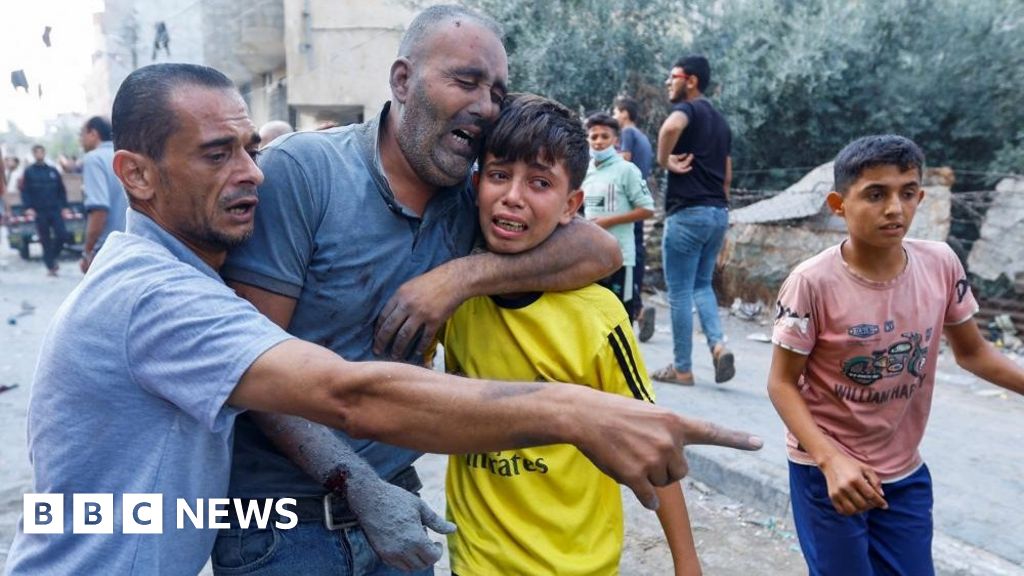
South Africa and Israel, despite geographical distance, share a complex historical tapestry woven with threads of political, economic, and social interaction. Understanding their trajectories, particularly the potential for accusations of genocide or atrocities, requires examining their distinct histories and the evolution of their relationship. This exploration will delve into the historical context, outlining significant events, highlighting key periods, and comparing the development of these two nations.
Historical Overview of South Africa
South Africa’s history is marked by profound inequalities and conflicts. From the arrival of European settlers and the subsequent subjugation of indigenous populations, the nation has grappled with racial segregation and oppression. The legacy of apartheid, a system of racial discrimination enforced by the government from 1948 to 1994, remains a significant scar on the nation’s past. The struggle against apartheid, involving various forms of resistance, ultimately led to the dismantling of the system and the establishment of a democratic South Africa.
Historical Overview of Israel
Israel’s history is deeply intertwined with its founding and the ongoing Israeli-Palestinian conflict. The establishment of the state in 1948 was met with significant resistance and conflict. The conflict has resulted in numerous wars and periods of tension. The historical context surrounding this conflict, including claims of displacement and violence, remains a point of contention and debate.
Evolution of Relations Between South Africa and Israel
The relationship between South Africa and Israel, despite their distinct historical contexts, evolved in complex ways. Initially, political and economic ties were present but became strained in the face of South Africa’s apartheid policies. The international condemnation of apartheid led to a global movement of divestment, and South Africa faced isolation on the world stage. This period saw Israel’s relations with South Africa being scrutinized by the international community.
Key Historical Periods in South Africa and Israel
| South Africa | Israel | Key Events/Tensions | Potential Conflicts/Tensions |
|---|---|---|---|
| Pre-colonial Era | Pre-state Era | Indigenous societies existed in South Africa. | Zionist movement emerges, leading to increased Jewish immigration. |
| Apartheid Era (1948-1994) | Establishment of the State of Israel (1948) | Systemic racial segregation and discrimination. | Arab-Israeli conflict escalates, including wars and displacement. |
| Post-Apartheid Era (1994-Present) | Ongoing conflict with Palestinians | Transition to a democratic society, reconciliation efforts. | Continued political and social challenges related to inequality and poverty. |
| 2000s-Present | Continued conflict with Palestinians, efforts for peace. | Continued efforts to address social and economic inequalities. | Potential for accusations of human rights violations, though not necessarily amounting to genocide. |
Comparison of Historical Trajectories
Comparing the historical trajectories of South Africa and Israel reveals both similarities and differences. Both nations experienced periods of significant conflict and tension. South Africa’s struggle against apartheid and Israel’s ongoing conflict with Palestinians both illustrate the challenges of nation-building in the face of deep-seated societal divisions. The context of both situations involves the potential for accusations of human rights violations, but not necessarily to the extent of genocide.
The difference lies in the scale of the conflict and the nature of the accusations.
Defining Genocide
The concept of genocide, a systematic attempt to destroy a national, ethnic, racial, or religious group, is a grave violation of international law. Understanding its legal definition is crucial for recognizing and preventing such atrocities. This framework allows for the identification of patterns and motivations behind these acts, enabling a more effective response to the threat of genocide.The definition of genocide, as enshrined in the 1948 Convention on the Prevention and Punishment of the Crime of Genocide, is not simply about mass murder.
It encompasses a broader range of actions aimed at destroying a group, often targeting its cultural identity and societal fabric.
Legal Definition of Genocide
The 1948 Convention on the Prevention and Punishment of the Crime of Genocide defines genocide as “acts committed with intent to destroy, in whole or in part, a national, ethnical, racial, or religious group.” This critical element of intent is crucial, as actions that cause significant harm but lack the specific intent to destroy a group are not considered genocide.
Criteria for Determining Genocide
Several criteria are used to determine if an event constitutes genocide. These include:
- The existence of a targeted group:
- The intent to destroy, in whole or in part, a targeted group:
- Specific acts committed to achieve the destruction of a group:
Identifying the specific group that is the target of the violence is essential. This group could be defined by nationality, ethnicity, race, or religion. This involves establishing clear evidence of the group’s identity and the perpetrator’s understanding of the group as a target.
This crucial element requires evidence of a deliberate plan to eliminate or significantly diminish the targeted group. This intent can be demonstrated through various means, including official pronouncements, propaganda, or actions that demonstrate the perpetrator’s goal to destroy the group.
These acts can include killing members of the group, causing serious bodily or mental harm, deliberately inflicting conditions of life calculated to bring about its physical destruction in whole or in part, imposing measures intended to prevent births within the group, or forcibly transferring children of the group to another group.
Acts Constituting Genocide
The Convention Artikels specific acts that may be considered components of genocide. These acts can range from physical violence to cultural destruction. It is important to note that the acts need to be carried out with the intent to destroy the targeted group.
- Killing members of the group:
- Causing serious bodily or mental harm to members of the group:
- Deliberately inflicting on the group conditions of life calculated to bring about its physical destruction in whole or in part:
- Imposing measures intended to prevent births within the group:
- Forcibly transferring children of the group to another group:
This is a clear example of an act of violence that may be considered genocide, if the intent to destroy is proven.
This includes actions that deliberately inflict severe physical or psychological harm on the group.
This encompasses actions that systematically undermine the survival of the group, such as starvation, denial of essential resources, or forced displacement.
This can include forced sterilization or denial of reproductive healthcare.
This is a particularly insidious act aimed at destroying the group’s cultural and social fabric by disrupting its future generations.
Key Actors and Motivations, South africa israel genocide
Genocide is rarely a spontaneous act. It typically involves key actors with specific motivations.
While the South Africa-Israel genocide is a complex and sensitive issue, it’s worth considering how financial mismanagement can also impact a nation’s stability. For instance, the recent embezzlement scandal at the Eugene Weekly, detailed in this article about Eugene Weekly embezzlement printing , highlights the corrosive effects of corruption. Ultimately, such issues can cast a long shadow over a community, just as the history of the South Africa-Israel genocide continues to affect many.
- Political leaders:
- Military forces:
- Extremist groups:
- Motivations:
Political leaders, often driven by ideologies of superiority or the desire to consolidate power, may initiate and direct acts of genocide.
Military forces often execute the perpetrators’ plans. Their motivation may stem from obedience to orders or the desire to gain personal advantage.
Extremist groups often play a key role in the execution of genocidal acts, driven by hatred and intolerance.
The ongoing debate around the South Africa-Israel genocide allegations is definitely complex. It’s fascinating to see how seemingly unrelated events, like the recent dropping of charges against Chris Young ( chris young charges dropped ), can still spark discussions about broader political issues. Ultimately, the South Africa-Israel genocide accusations remain a significant point of contention, with many different perspectives and layers of interpretation.
These include, but are not limited to, ethnic or racial hatred, religious extremism, political opportunism, and the desire to eliminate perceived threats.
Historical Events Related to Genocide
Numerous historical events have been investigated and discussed in relation to genocide. These events highlight the destructive potential of such actions.
- The Armenian Genocide (1915-1923):
- The Holocaust (1933-1945):
- The Rwandan Genocide (1994):
- The Bosnian Genocide (1992-1995):
The Ottoman Empire’s systematic extermination of the Armenian population is a prime example of genocide.
The Nazi regime’s persecution and murder of Jews is a horrific example of genocide.
The Hutu extremists’ mass slaughter of Tutsis is a stark reminder of the devastating consequences of genocide.
The Serbs’ systematic violence against Bosnian Muslims and Croats illustrates the persistence of genocide in modern times.
South African Context
The history of South Africa is deeply intertwined with the legacy of racial discrimination and segregation. From the arrival of European settlers to the establishment of the apartheid system, the nation endured a brutal period of oppression and resistance. Understanding this context is crucial to comprehending the magnitude of the suffering inflicted and the persistent struggle for equality that continues to shape South Africa today.The relentless pursuit of racial domination and exploitation laid the foundation for the systematic oppression that defined the apartheid era.
This era witnessed a complex interplay of state-sanctioned violence, economic disenfranchisement, and social marginalization. This system of racial hierarchy permeated every facet of South African life, profoundly impacting the daily experiences of all racial groups.
History of Racial Discrimination and Segregation
The arrival of Dutch settlers in the 17th century marked the beginning of a complex relationship between different racial groups in South Africa. This interaction, often marked by conflict and exploitation, set the stage for the development of racial hierarchies that would later solidify into the apartheid system. The Dutch settlers, along with subsequent British colonization, gradually established a system of racial classifications, with the indigenous African population systematically relegated to a subordinate status.
This early period saw the implementation of discriminatory laws and practices that laid the groundwork for future racial segregation.
Overview of the Apartheid System and its Impact
The apartheid system, formally implemented in the mid-20th century, was a comprehensive system of racial segregation and discrimination. It enforced strict racial classifications, creating separate residential areas, educational institutions, and public facilities for different racial groups. This system aimed to maintain white minority dominance and suppress the rights and aspirations of non-white South Africans. Apartheid had devastating economic consequences, as it limited opportunities for black South Africans and fostered widespread poverty and inequality.
Role of Specific Individuals and Groups during the Apartheid Era
The apartheid regime relied on the cooperation of certain individuals and groups to maintain its oppressive policies. White Afrikaner nationalists played a key role in establishing and implementing apartheid laws. Meanwhile, numerous anti-apartheid activists, including Nelson Mandela and other leaders in the African National Congress (ANC), fought relentlessly against the system. These individuals and groups, from various backgrounds, embodied the stark contrast between oppression and resistance.
Strategies and Tactics Employed by Anti-Apartheid Movements
Anti-apartheid movements employed a variety of strategies to challenge the oppressive system. These included peaceful protests, boycotts, acts of civil disobedience, and armed resistance. The choice of strategy often depended on the specific context and the perceived effectiveness in challenging the regime. The different tactics employed reflected the diverse experiences and perspectives within the anti-apartheid movement.
Comparison and Contrast of Experiences of Different Racial Groups
The apartheid system profoundly affected the experiences of different racial groups in South Africa. White South Africans, as the dominant group, generally enjoyed preferential treatment in terms of economic opportunities, political power, and access to resources. Conversely, black South Africans, and other non-white groups, faced severe restrictions and limitations in all aspects of life. The experiences varied within each group, with some facing more extreme hardships and marginalization.
South African Government Responses to International Criticisms Regarding Apartheid
The South African government consistently resisted international criticisms of apartheid, often arguing that the system was a matter of internal affairs. The government employed various strategies to deflect international pressure, including diplomatic maneuvers and economic policies. These responses demonstrated the government’s commitment to maintaining the apartheid system and its defiance of the global community’s condemnation.
Israeli Context
The establishment of Israel in 1948, amidst the backdrop of the Arab-Israeli conflict, marked a pivotal moment in the region’s history. This event, deeply intertwined with the historical claims and aspirations of both Jewish and Palestinian communities, continues to shape the geopolitical landscape of the Middle East. The subsequent conflicts, characterized by complex political dynamics and competing narratives, have profoundly impacted the lives of millions.The Israeli-Palestinian conflict is a multifaceted issue, rooted in historical grievances and competing national aspirations.
Understanding this conflict requires acknowledging the diverse perspectives and experiences of those involved, and recognizing the enduring impact of displacement and loss on affected populations. The role of key figures and groups in shaping Israeli politics and policies is also crucial to comprehending the evolution of the conflict. Finally, Israel’s interactions with international organizations provide insight into the ongoing attempts to achieve a peaceful resolution.
History of Israel’s Establishment and Conflicts
Israel’s establishment in 1948 was preceded by centuries of Jewish diaspora and the Zionist movement’s goal of creating a Jewish homeland in Palestine. The region had a complex demographic history, with both Jewish and Palestinian communities residing there. The 1948 Arab-Israeli War, following the UN partition plan, resulted in the displacement of Palestinians and the creation of Israel.
Timeline of Significant Events
- 1947: The UN General Assembly votes on the partition plan, dividing Palestine into Arab and Jewish states. This plan was a crucial attempt at resolving the conflict, but it ultimately failed to achieve its goal of peace and stability in the region. The plan, while attempting to address the historical claims of both communities, ultimately failed to account for the complex socio-political dynamics and deep-seated historical grievances that continue to plague the region to this day.
The partition plan, despite the efforts of the UN, proved to be insufficient in addressing the underlying issues that fueled the conflict.
- 1948: The Israeli Declaration of Independence and the subsequent Arab-Israeli War, leading to the displacement of hundreds of thousands of Palestinians. This war resulted in a significant loss of life and the disruption of established communities, leaving a lasting scar on the region’s history. The war, while marked by significant casualties and losses, also highlighted the deeply entrenched political and ideological differences that continue to hinder progress towards a peaceful resolution.
- 1967: The Six-Day War, resulting in Israeli occupation of the West Bank, Gaza Strip, and East Jerusalem. This war significantly altered the political landscape of the region, with Israel gaining control of territories that had been previously held by Arab states. The conflict brought into sharp focus the long-standing territorial disputes and the competing national aspirations that fueled the ongoing conflict.
- 1993: The Oslo Accords, aiming at a peaceful resolution. These accords represented a significant step towards achieving a two-state solution, but ultimately failed to achieve a lasting peace agreement. The Oslo Accords, while intended to be a pivotal moment in the peace process, proved insufficient in overcoming the complex political realities and deeply entrenched positions of both sides.
Perspectives of Various Groups Involved
- Jewish Israelis: View the establishment of Israel as a fulfillment of historical and religious aspirations, seeing it as a homeland for the Jewish people after centuries of diaspora. The establishment of Israel is a complex issue that is viewed differently by different Jewish Israelis, with some supporting the current state’s policies while others criticize them. The diverse viewpoints of Jewish Israelis regarding the establishment of Israel reflect the multifaceted nature of this complex historical event.
- Palestinian Arabs: View the establishment of Israel as an act of displacement and dispossession, leading to the loss of land and homes. Palestinians have a strong sense of belonging to the land, and the establishment of Israel has had a profound impact on their lives and their ability to maintain their cultural and national identity.
- International Community: Offers varying perspectives, with some supporting Israeli claims and others focusing on Palestinian grievances. The international community has taken various stances on the Israeli-Palestinian conflict, highlighting the complex and often contradictory nature of international diplomacy and the difficulty of achieving a consensus on this sensitive issue.
Palestinian Displacement and Impact on Populations
The displacement of Palestinians during and after the 1948 Arab-Israeli War had a devastating impact on Palestinian communities. Loss of land, homes, and livelihoods led to significant hardship and a sense of injustice. This displacement continues to affect generations of Palestinians. The impact of displacement on Palestinian populations is multi-layered, encompassing both immediate and long-term consequences.
Role of Specific Groups and Individuals
Various political parties, leaders, and activists have shaped Israeli politics and the conflict. Understanding the role of these individuals and groups is crucial for comprehending the evolution of the conflict. Examples of such figures and their influence on the political landscape of Israel include David Ben-Gurion, Golda Meir, and Yitzhak Rabin, among others.
Israel’s Relations with International Organizations
Israel’s relations with international organizations, particularly the United Nations, have been marked by complex interactions. These relations have been characterized by differing viewpoints and varying levels of support for Israeli and Palestinian claims. Israel’s relations with international organizations have often been characterized by diplomatic tensions and disagreements, reflecting the complex political dynamics of the conflict.
Potential Connections
The exploration of potential connections between the historical experiences of South Africa and Israel and the concept of genocide is a complex and sensitive undertaking. It requires a meticulous examination of historical events, legal definitions, and the diverse perspectives surrounding these events. A critical approach is essential, acknowledging the sensitivities involved and avoiding generalizations.The examination of potential connections necessitates a careful consideration of the historical and political contexts within which these events unfolded.
This includes understanding the motivations, actions, and consequences of the actors involved, as well as the broader socio-political landscapes that shaped these events. This analysis also requires careful consideration of the different perspectives and interpretations of these events, acknowledging the diverse opinions and experiences of individuals and groups affected by them.
Potential Arguments for a Connection in South Africa
The apartheid regime in South Africa systematically oppressed and discriminated against Black South Africans. This involved the denial of fundamental human rights, forced removals, and the creation of a racially segregated society. Some argue that these actions, while not immediately categorized as genocide under international law, represent a pattern of state-sponsored violence and systematic discrimination that meets certain criteria of genocide in terms of intent.
These arguments highlight the deliberate and pervasive nature of the state-sponsored oppression, aimed at achieving and maintaining a specific social order.
Potential Arguments for a Connection in Israel
The Israeli-Palestinian conflict has been marked by periods of violence and displacement. Arguments for connecting these events to the concept of genocide often center on allegations of deliberate actions aimed at the destruction or suppression of Palestinian populations or culture. These arguments typically focus on specific instances of violence and displacement, arguing that these actions constitute acts of genocide under international law.
Factors Influencing Perception of Potential Genocide
The perception of potential genocide in both South Africa and Israel is significantly influenced by a variety of factors. These include the historical narratives constructed by different groups, the political and social climates surrounding these events, and the role of international actors in shaping public discourse. The interpretation of specific events, such as instances of violence or displacement, can vary significantly depending on the perspectives and priorities of those involved.
Comparison of Historical and Political Contexts
While both South Africa and Israel have experienced complex and violent histories, their contexts differ significantly. South Africa’s struggle involved racial segregation and oppression by a state apparatus. Israel’s history is characterized by conflict and territorial disputes, with differing interpretations of historical events and the nature of the conflict. The historical and political contexts are crucial in understanding the diverse perspectives surrounding these events.
Diversity of Opinions on Potential Connections
There is no consensus on whether the events in South Africa or Israel meet the legal definition of genocide. Different groups and individuals hold varying interpretations of the historical events, motivations, and consequences. These diverse opinions underscore the complexity of the issues and the need for careful consideration of the specific circumstances. This diversity of opinion emphasizes the sensitive nature of the discussion and the importance of nuanced analysis.
Evidence and Documentation
Examining accusations of genocide requires a meticulous review of evidence. This section delves into potential evidence related to these accusations in both South Africa and Israel, examining various sources and assessing their reliability. The analysis emphasizes documented human rights violations and potential connections between them and the criteria for genocide.Potential evidence for accusations of genocide can take many forms.
This includes official government documents, eyewitness accounts, photographic and video evidence, and statistical data on population displacement, deaths, or other harms. Determining the validity of such evidence is crucial, as accusations of genocide carry significant weight and impact international relations.
Potential Evidence Related to South Africa
Evidence supporting claims of genocide in South Africa, particularly during the apartheid era, exists in various forms. Historical records, including government reports, official decrees, and legal documents, provide insights into discriminatory policies and practices. Eyewitness accounts from victims and survivors, often collected in oral histories or legal depositions, are valuable primary sources. Documentation of forced removals, massacres, and other forms of violence perpetrated by the state are integral to understanding the potential for genocide accusations.
Potential Evidence Related to Israel
The potential evidence regarding accusations of genocide in Israel involves similar elements, including government documents, eyewitness accounts, and human rights reports. Specific instances of alleged violence against specific populations are crucial. Examining the displacement of populations, the destruction of infrastructure, and the systematic targeting of civilians, often documented by NGOs and international observers, are necessary to assess the potential for genocidal intent.
Table of Sources
This table Artikels potential sources of information regarding accusations of genocide in South Africa and Israel. Each source type’s reliability and credibility need to be assessed critically.
| Source Category | South Africa (Apartheid Era) | Israel (Specific Conflicts) | Reliability Assessment |
|---|---|---|---|
| Government Documents | Official decrees, reports on population control, records of forced removals | Reports on military actions, internal security reports, documentation of demolitions | Potentially biased, but can provide context and evidence of official policies. Careful scrutiny required. |
| Eyewitness Accounts | Oral histories, testimonies in legal proceedings, accounts in personal journals | Statements by victims, accounts from human rights organizations, personal accounts on social media | Subjective and potentially influenced by trauma. Cross-referencing with other evidence is critical. |
| Human Rights Reports | Reports from organizations like Amnesty International and Human Rights Watch on abuses | Reports from international organizations and NGOs on alleged war crimes and human rights abuses | Often based on field research and investigations. Vary in objectivity and methodology. |
| Statistical Data | Data on population displacement, mortality rates, and other indicators of harm | Data on civilian casualties, damage to property, displacement of populations | Can provide a quantitative perspective but may require careful interpretation and contextualization. |
Reliability and Credibility of Sources
Assessing the reliability and credibility of sources is paramount. Government documents, while potentially containing evidence of policies, may be presented in a way that downplays or obscures abuses. Eyewitness accounts are invaluable but can be colored by personal experiences and trauma. Human rights reports, often based on thorough investigations, provide an important perspective, yet potential bias should be acknowledged.
Statistical data can offer insights into patterns but requires contextualization.
Documented Accounts of Human Rights Violations
Numerous documented accounts detail human rights violations in both South Africa and Israel, particularly during periods of conflict and unrest. These accounts, gathered by various sources, offer insights into potential patterns of systematic violence. Examples include:
- In South Africa, the documented abuses of the apartheid era, including forced removals, massacres, and denial of basic human rights, demonstrate a pattern of systemic discrimination. This evidence suggests a pattern of targeted persecution, a key element of genocide.
- In Israel, during specific conflicts, accounts of civilian casualties, property destruction, and displacement of populations raise concerns about the potential for human rights violations and potentially genocide. Detailed examination of these incidents, coupled with evidence of broader policy or practice, is necessary to assess the potential for genocidal intent.
International Responses
International responses to potential human rights violations, particularly those escalating towards genocide, are crucial for preventing and mitigating atrocities. Effective action often hinges on the timely and decisive intervention of international organizations and the application of international law. The historical record shows that inaction or inadequate responses can have devastating consequences.International organizations, like the United Nations, play a vital role in monitoring and addressing potential human rights violations.
The South African and Israeli governments have faced accusations of complicity in various human rights abuses, and the historical context is complex. However, the tragic stories of love and loss, like that of Keren Blankfeld and József Debreczeni, found amidst the horrors of Auschwitz lovers in auschwitz keren blankfeld cold crematorium jozsef debreczeni , serve as a stark reminder of the devastating impact of conflict and the enduring human spirit.
These narratives, though separated in time and place, highlight the interconnectedness of suffering and the need for justice in all corners of the world, a crucial point when considering the broader context of South Africa-Israel relations.
Their mandate encompasses promoting peace, preventing conflicts, and protecting vulnerable populations. This involves deploying peacekeeping forces, facilitating diplomatic negotiations, and providing humanitarian aid. However, these efforts are not always successful, and significant challenges often arise in implementing effective interventions.
Role of International Organizations
International organizations, primarily the United Nations, are tasked with maintaining international peace and security. This includes preventing conflicts, protecting human rights, and providing humanitarian assistance. The UN Charter establishes the framework for these actions, emphasizing the importance of collective security and the responsibility to protect. Their role extends to identifying potential threats, deploying peacekeeping missions, and mediating disputes.
The UN Security Council, with its unique authority, can authorize the use of force in cases of imminent threats to peace.
Examples of International Interventions
The UN has engaged in numerous interventions in response to conflicts and atrocities throughout history. These interventions vary in scope and intensity, ranging from diplomatic efforts to the deployment of peacekeeping forces. Examples include the UN peacekeeping operations in the Democratic Republic of Congo and the deployment of observers in various conflict zones. The success of these interventions is often measured by the extent to which they prevent further violence, protect civilians, and promote long-term stability.
Important to note is that these interventions are not always successful and often face significant challenges.
Application of International Law
International criminal law plays a crucial role in holding individuals accountable for atrocities. The establishment of the International Criminal Court (ICC) provides a mechanism for prosecuting individuals accused of genocide, war crimes, crimes against humanity, and other serious violations of international law. However, the ICC’s jurisdiction is not universal, and its effectiveness is contingent on the cooperation of states.
The application of international law often depends on the willingness of states to cooperate and extradite suspects, as well as the availability of evidence. The prosecution of individuals for genocide, war crimes, and crimes against humanity demonstrates a commitment to holding perpetrators accountable.
Effectiveness of International Responses
The effectiveness of international responses in preventing or addressing genocide is a complex and contested issue. While some interventions have demonstrably prevented further atrocities, others have failed to prevent or effectively address them. The effectiveness is often contingent on several factors, including the severity of the situation, the willingness of states to cooperate, and the resources available to international organizations.
For instance, the international community’s response to the Rwandan genocide is often cited as a failure to prevent a horrific tragedy.
Challenges Faced by International Organizations
International organizations face significant challenges in intervening in conflicts. These challenges include the lack of resources, political will, and cooperation from member states. The complexities of internal conflicts, the presence of armed groups, and the protection of civilians within these conflicts are significant obstacles. The protection of humanitarian workers and the provision of aid in conflict zones are also significant challenges.
The ongoing debate surrounding the South Africa-Israel conflict highlights the complex interplay of historical grievances and contemporary geopolitical factors. While the world focuses on issues like the burgeoning electric vehicle (EV) sector in Chinese cities like Hefei, china hefei ev city economy is rapidly changing the landscape of urban infrastructure and innovation. Ultimately, the focus must remain on the fundamental issues driving the South Africa-Israel genocide debate, and the need for a lasting and peaceful resolution.
The political and economic interests of powerful nations can also impede effective intervention.
Comparative Analysis
Comparing the situations in South Africa and Israel, while both facing accusations of systemic violence and oppression, reveals significant differences in historical context, political dynamics, and international responses. Both nations have experienced periods of intense conflict and accusations of human rights violations, but the specifics and the interpretations of those events differ considerably. Understanding these nuanced differences is crucial for a balanced assessment of the accusations.A comparative analysis necessitates examining the unique historical trajectories, the specific accusations, and the varied reactions of the international community.
The different perspectives and arguments surrounding potential genocide in both contexts highlight the complexity of these issues and the difficulty in reaching a universally agreed-upon definition. Critically evaluating the evidence, acknowledging the historical context, and understanding the different viewpoints are essential for an informed discussion.
Similarities in Historical Events and Accusations
Both South Africa under apartheid and Israel, particularly during the Palestinian conflict, have faced accusations of systematic violence and human rights violations. These accusations often involve targeted oppression, denial of basic rights, and the use of force against minority groups. While the specific actions and targets differ, the underlying theme of systemic injustice is present in both cases.
Differences in Historical Events and Accusations
The specific historical events and the nature of the accusations differ significantly. South Africa’s apartheid system involved the systematic disenfranchisement and oppression of a racial minority. Israel’s conflict with Palestinians, on the other hand, centers on land disputes, self-determination, and the occupation of territories. These differing contexts lead to different interpretations of the actions and motivations of the involved parties.
Comparative Table of Key Differences and Similarities
| Feature | South Africa (Apartheid) | Israel (Palestinian Conflict) | Similarities |
|---|---|---|---|
| Historical Context | Systemic racial segregation and oppression enforced by law | Complex history of land disputes, claims of self-determination, and military conflicts. | Allegations of human rights violations and potential for state-sponsored violence. |
| Nature of Accusations | Genocide of a minority group through denial of rights and violence. | Genocide of Palestinians, often focusing on displacement and collective punishment. | Both cases involving accusations of systemic violence against a specific group. |
| International Response | Strong international condemnation and sanctions, including boycotts and divestment campaigns. | Varying international responses, with some nations condemning specific actions while others express reservations. | Both situations attracted international attention and criticism. |
| Evidence and Documentation | Extensive documentation of human rights abuses by the apartheid regime. | Disputed evidence of human rights abuses and varying perspectives on the accuracy and interpretation of the available documentation. | Both cases require careful examination of evidence and interpretation. |
Varying Perspectives of Different Groups in the International Community
International responses to the situations in South Africa and Israel have been diverse and often contested. Some nations have strongly condemned specific actions, while others have expressed reservations or nuanced perspectives, often influenced by political and geopolitical factors. These varied responses reflect the complexity of the issues and the difficulties in achieving consensus. The involvement of different nations in either condemning or defending certain actions often reflects their political and economic interests.
Arguments and Counterarguments Related to Potential Genocide
Arguments for potential genocide in both cases rely on the accumulation of evidence demonstrating systematic and widespread violence and violations of human rights. These arguments typically cite instances of targeted killings, suppression of dissent, and denial of basic rights. Counterarguments often emphasize the nuances of the historical context, the complexities of political motivations, and the interpretation of the available evidence.
The South African-Israeli conflict, while complex, often gets overshadowed by larger global issues. Recent events, like the controversial Koch Chevron deference to the Supreme Court, demonstrate how powerful interests can shape legal outcomes , which in turn could potentially affect the geopolitical landscape and perhaps influence future decisions regarding similar conflicts, such as the one in South Africa involving Israel.
This raises further questions about the underlying motivations driving these actions.
The different perspectives and arguments highlight the challenges in defining and proving genocide.
Visual Representation
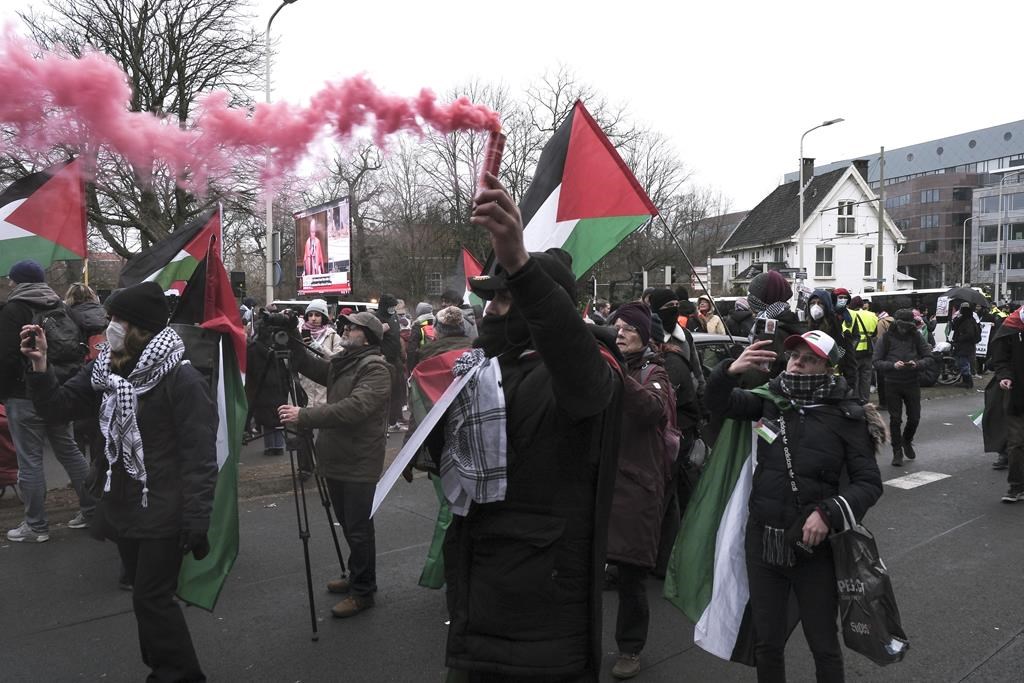
Visual representations are crucial for understanding complex historical contexts and potential connections. They offer a concise and accessible way to grasp intricate details and relationships that might otherwise be lost in lengthy text. This section details several visual representations that can help to visualize the historical contexts, potential conflicts, stages of potential genocide, international responses, and evidence in relation to the accusations.
Historical Context Timeline
A timeline is an effective tool for visualizing the historical contexts of both South Africa and Israel. This timeline should be chronologically arranged, highlighting significant events, such as political movements, social changes, and major conflicts. For example, the timeline could cover the apartheid era in South Africa, alongside the Israeli-Palestinian conflict, showcasing key dates, events, and developments that contribute to the current political landscape.
This visualization will allow viewers to grasp the interconnectedness of historical events in shaping the present.
Conflict Zones Map
A map depicting potential areas of conflict or tension is a useful visual tool. This map should clearly mark geographical regions where conflicts or tensions have occurred. The map should use different colors or symbols to distinguish between different types of conflict or tension, such as political disputes, military actions, or social unrest. This map will highlight the spatial distribution of potential conflict zones, allowing for a visual understanding of the areas most affected by these tensions.
Stages of Potential Genocide Flowchart
A flowchart illustrating the stages of potential acts of genocide can help to clarify the progression of such actions. This flowchart should depict the key phases involved, from initial discrimination and dehumanization to organized violence and destruction. Examples of these phases could include hate speech, incitement, restrictions on freedom, and eventually, the systematic targeting of specific groups. The flowchart should include branching paths to illustrate the different potential outcomes and the interplay of factors that may contribute to a genocide.
International Response Organization Chart
An organizational chart outlining the roles of international organizations in response to events can be beneficial. This chart should clearly identify the different organizations involved, such as the United Nations, the International Criminal Court, and relevant human rights bodies. The chart should visually display the reporting structure and interconnectedness of these organizations, highlighting the chain of command and the potential for cooperation or conflict in response to events.
Evidence and Documentation Visualization
A visual representation of potential evidence and documentation could take the form of a table or matrix. This table could list different types of evidence, such as eyewitness accounts, official documents, photographs, and forensic data. Each type of evidence should be categorized and potentially color-coded to represent the different sources and their levels of credibility. This visualization will help viewers to understand the different types of evidence available and how it is connected to the accusations.
Last Point
In conclusion, the examination of South Africa and Israel within the framework of potential genocide reveals a multifaceted historical context. While no definitive conclusions are drawn here, this exploration highlights the importance of understanding the historical circumstances and the varied perspectives surrounding these serious accusations. The analysis underscores the need for careful consideration of evidence, documentation, and international responses in addressing such claims.
Further research is crucial to gain a deeper understanding.
User Queries: South Africa Israel Genocide
What is the legal definition of genocide according to international law?
The legal definition of genocide, as Artikeld in the Convention on the Prevention and Punishment of the Crime of Genocide, encompasses the intent to destroy, in whole or in part, a national, ethnic, racial, or religious group. This includes acts like killing members of the group, causing serious bodily or mental harm, deliberately inflicting conditions of life calculated to bring about its physical destruction in whole or in part, imposing measures intended to prevent births within the group, and forcibly transferring children of the group to another group.
What is the role of international organizations in addressing potential human rights violations?
International organizations, such as the United Nations, play a crucial role in addressing human rights violations. These organizations often investigate allegations, provide humanitarian aid, and attempt to mediate conflicts. However, their effectiveness can be limited by factors such as political will, resource constraints, and the complexities of the situations they encounter.
What is the difference between the apartheid system and the Israeli-Palestinian conflict?
While both situations involve significant human rights concerns, the apartheid system in South Africa primarily focused on racial segregation and discrimination, whereas the Israeli-Palestinian conflict involves complex issues of land ownership, self-determination, and the creation of a nation state. Different historical contexts and motivations shape the nature of the conflicts.

